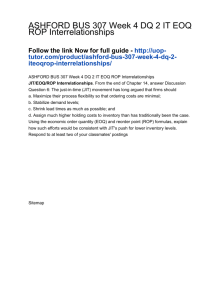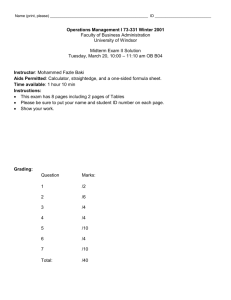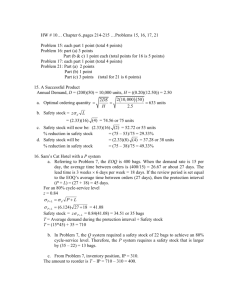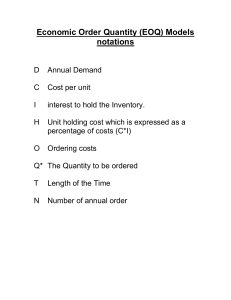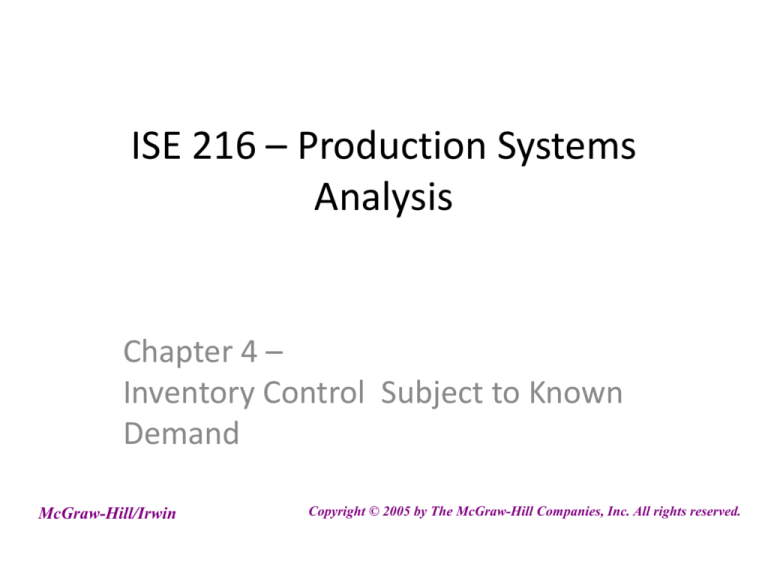
ISE 216 – Production Systems
Analysis
Chapter 4 –
Inventory Control Subject to Known
Demand
McGraw-Hill/Irwin
Copyright © 2005 by The McGraw-Hill Companies, Inc. All rights reserved.
This Chapter
• Considers inventory control policies for
individual item when product demand is
assumed to follow a known pattern
• Assumes zero forecast error.
– Is this realistic? Hardly, but it is easier.
– Do not worry we will get to the more realistic
cases
Why do we study inventory?
Investment in Inventories in the U.S. Economy (1999)
Inventory is money.
Reasons for Holding Inventories
•
•
•
•
•
•
Economies of scale
Uncertainty in delivery lead times
Speculation (Changing costs over time)
Smoothing
Demand uncertainty
Costs of maintaining control system
Characteristics of Inventory Systems
• Demand
– May be known or uncertain
– May be changing or constant in time
• Lead Times (time elapses from placement of
order until its arrival)
– known
– unknown
• Review policy: Is the system reviewed
– periodically
– continuously
Characteristics of Inventory Systems
• Treatment of Excess Demand
– Backorder all excess demand
– Lose all excess demand
– Backorder some and lose some
• Inventory that changes over time
– perishability
– obsolescence
Relevant Costs
• Holding Costs - Costs proportional to the quantity
of inventory held. Includes:
– Physical space cost (3%)
– Taxes and insurance (2 %)
– Breakage, spoilage and deterioration (1%)
– Opportunity Cost of alternative investment (18%)
(in total: 24% of all costs)
Note: Since inventory level is changing on a
continuous basis, holding cost is proportional to
the area under the inventory curve
Inventory as a Function of Time
Relevant Costs (continued)
• Penalty or Shortage Costs (opposite of
holding ): All costs that happen when the stock is
insufficient to meet the demand
– Loss of revenue for lost demand
– Costs of bookkeeping for backordered demands
– Loss of goodwill for being unable to satisfy the
demand
– Generally assumed cost is proportional to
number of units of excess demand
Relevant Costs (continued)
• Ordering Cost (or Production Cost) - has both
fixed and variable components
slope = c
K
x : order or production quantity
C(x): ordering or production cost
C(x) = K + cx for x > 0
C(x) = 0 for x = 0.
Simple Economic Order Quantity
(EOQ) Model – Assumptions
1. Demand is constant and uniform (l units/year,
l/4 units per quarter)
2. Shortages are not allowed
3. Orders are received instantaneously
4. Order quantity is fixed (Q per cycle) - can be
proven to be optimal
5. Costs
– Fixed and marginal ordering costs (K + cQ)
– Holding cost per unit held per unit time (h)
Inventory Levels for the EOQ Model
First order when inventory is 0. Reorder Q units every time
when inventory is 0. It must be optimal
The EOQ Model: Notation
Parameters
λ : the demand rate (in units per time)time
c : unit ordering/roduction cost (in dollars per unit),
setup or inventory costs are not included
K : setup cost (per placed order) in dollars
h : holding cost (in dollars per unit per year)
if the holding cost consists of interest of the
money tied up in inventory,
h = ic, where
i is the annual interest rate
The EOQ Model: Notation
Decision variable is Q
Q: lot size (order size) in units
T : time between two consecutive orders (cycle
length)
T
Q
l
G(Q) = average cost per unit time
Relationships
• Ordering Cost per cycle:
C(Q) = K + cQ
• Holding Cost per cycle =
unit holding cost * area of the triangle
h * QT/2
or
unit holding cost * average inventory size * cycle length
h*Q/2*T
Relationships
• Average Inventory Size = Q/2 why ?
Inventory (I(t))
Assume Constant Demand
slope = -l
Q
T
Time between orders
Time (t)
Instantaneous
Replenishment
• Time Between Orders (Cycle length)
Q
l Q/T
T = Q/l
Rate of consumption
l
T
Total Costs
• What is the average annual cost?
G(Q) = average total (order + holding) cost
= total cost per cycle / cycle length
Q
K cQ hT
K cQ
Q
2
G (Q )
h
T
T
2
Ordering
cost per cycle
Average inventory
level at any time
Average total cost
• What is the average annual cost?
K cQ hQ
G (Q)
T
2
K cQ hQ
Q
2
l
hQ Kl
lc
2
Q
The Average Annual Cost Function G(Q)
Q K cQ hQ Kl
GQ ) h
cl
2 T
T
2
Q
Q that minimizes the annual cost
G Q ) is a nonlinear function of Q
Let Q* be the optimal Q value. Is G’(Q*)=0 ?
Kl
hQ
G (Q )
lc
Q
2
Kl h
G (Q ) 2
Q
2
2K l
G (Q) 3 0, when Q 0
Q
YES!
Kl h
2K l
2 0 Q*
Q
2
h
Properties of the EOQ Solution
2K l
Q*
h
• Q* is increasing function of K and l and
decreasing function of h in square roots
• Q* is independent of c (except the case we
calculate h = Ic), Why?
Properties of the EOQ Solution
hQ Kl
G Q )
cl
2
Q
Q
2 Kl
h
• This formula is well-known as economic order quantity,
is also known as economic lot size
• This is a tradeoff between lot size (Q) and inventory
• “Garbage in, garbage out” - usefulness of the EOQ
formula for computational purposes depends on the
realism of the input data
• Estimating setup cost is not easily reduced to a single
invariant cost K
Example
• UVIC annually requires 3600 liters of paint for scheduled
maintenance of buildings.
• Cost of placing an order is $16 and the interest rate (annual)
is 25%. Price of paint is $8 per liter. How many liters of
paint should be ordered and how often?
2K l
2(16)(3600)
Q*
57600 240
h
0.25(8)
Q
240
0.07 years * 250 working days a/year
T
l 3600
= 17.5=18 working days
Order Point for the EOQ Model
τ
τ
τ
τ
Assumption: Delivery is immediate or order lead time τ = 0
Order Point for the EOQ Model
• Does it matter if τ < T or τ > T ?
• Keep track of time left to zero inventory or set to
automatic reorder at a particular inventory level, R.
• Two cases:
1. if τ < T
2. if τ > T
R = λ*τ,
R = λ* (τ mod T)
Sensitivity Analysis
G(Q) : the average annual holding and set-up cost
function
hQ Kl
G Q )
cl
2
Q
hQ Kl
G Q )
2
Q
independent of Q and omitted
Q
2 Kl
h
G*: the optimal average annual holding and setup cost
G 2 hK l
Sensitivity Analysis
Ratio of opt. to Suboptimal
Cost
Sensitivity of EOQ to Order Quantity
6,000
5,000
4,000
3,000
2,000
1,000
0,000
0
2
4
6
8
10
Ratio of Optimal to Suboptimal Quant.
G (Q) 1 Q * Q
G*
2 Q Q *
Cost penalties are quite small
Finite Replenishment Rate:
Economic Production Quantity (EPQ)
Assumptions of EOQ:
1. Production is instantaneous: There is no capacity
constraint, and entire lot is produced simultaneously
2. Delivery is immediate: There is no time lag between
production and availability to satisfy demand
Inventory Levels for Finite
Production Rate Model
Assumption : production rate is P (P > λ), arriving continuously.
The EPQ Model: Notation
Parameters
λ : the demand rate (in units per year)
P : the production rate (in units per year)
c : unit production cost (in dollars per unit)
K : setup costs (per placed order) in dollars
h : holding cost (in dollars per unit per year) if the interest rate is
given calculated as h=ic,
Decision variables
Q : size of each production run (order) in units
T : time between two consecutive production orders (cycle
length)
T T1 T2
T1 : production (replenishment) time
T2 : no production (down time)
H : maximum on-hand inventory level
The EPQ Model: Formula
Q
T1
P
T T1 T2
Q
Q
T2 T T1
l P
Q
H P l ) T1 ( P l )
P
The EPQ Model: Formula
HT
h
K cQ
l Q Kl
2
G Q )
h 1
cl
T
P 2 Q
For EPQ:
2K l
l
Q
, where h h 1
h
P
For EOQ:
2 Kl
Q
h
Quantity Discount Models
• The assumption is “The unit variable cost c did not
depend on the replenishment quantity”
• In practice quantity discounts exist based on the
purchase price or transportation costs
• Two types of discounts:
– All Units Discounts: the discount is applied to ALL of the units
in the order.
• Order cost function such as that pictured in Figure 4-9 in Ch.
4.7
– Incremental Discounts: The discount is applied only to the
number of units above the breakpoint.
• Order cost function such as that pictured in Figure 4-10
All-Units Discount Order Cost Function
C 499) $149.70
C (500) $145.00
C (516) $149.64
0.30Q
C Q ) 0.29Q
0.28Q
for 0 Q 500
for 500 Q 1,000
for 1,000 Q
All-Units Discount
Average Annual Cost Function
G(Q)
0.30Q
C Q ) 0.29Q
0.28Q
for 0 Q 500
for 500 Q 1,000
for 1,000 Q
G0(Q)
G1(Q)
G2(Q)
Gmin(Q)
500
1,000
Q
Incremental Discount Order Cost Function
0.30Q
for Q 500
C Q ) 150 0.29 Q 500 ) 5 0.29Q
for 500 Q 1, 000
295 0.28 Q 1, 000 ) 15 0.28Q for 1, 000 Q
Average Annual Cost Function
for Incremental Discount Schedule
Properties of the Optimal Solutions
• For all units discounts, the optimal will occur
at the minimum point of one of the cost
curves or at a discontinuity point
– One compares the cost at the largest realizable
EOQ and all of the breakpoints succeeding it
• For incremental discounts, the optimal will
always occur at a realizable EOQ value.
– Compare costs at all realizable EOQ’s.
Example
• Supplier of paint to the maintenance department
has announced new pricing:
$8 per liter if order is < 300 liters
$6 per liter if order is ≥ 300 liters
• Other data is same as before:
K = 16, i= 25%, l = 3600
• Is this a case of all units or incremental discount?
Solution
• Step 1: For price 1:
Q1*
2K l
2(16)(3600)
240 liters
ic1
(0.25)(8)
• Step 2: As Q(1) < 300, EOQ is realizable.
• Step 3: For price 2:
Q2*
2K l
2(16)(3600)
277 liters
Ic2
(0.25)(6)
• Step 4: As Q(2) < 300, EOQ is not realizable.
Cost Function
C(Q)
Realizable
G(Q|c1)
G(Q|c2)
Not
Realizable
240 277
300
Q
C(Q)
Cost Function
Only possible solutions G(Q|c )
1
G(Q|c2)
240 277
300
Q
Solution
• Step 5: Compare costs of possible solutions.
Q lK
G j (Q) ic j
lc j
2 Q
– For $8 price, Q=240:
(3600)(16) (0.25)(8)(240)
G1 (240) (3600)(8)
$29280 per year
240
2
– For $6 price, Q=300:
(3600)(16) (0.25)(6)(300)
G2 (300) (3600)(6)
$22017 per year
300
2
– Q=300 is the optimal quantity.
Q * 300
1
Q* 300 and T *
year
l 3600 12
Resource Constrained Multi-Product Systems
• Classic EOQ model is for a single item.
• If we have multiple (n) items
– Option A: Treat one system with multiple items as one
item
• Works if there is no interaction among the items, such
as sharing common resources – budget, storage
capacity, or both
– Option B: Modify classic EOQ to insure no violation of the
resource constraints
• Works if you know how to use Lagrange multipliers!
Resource Constrained Multi-Product Systems
• Consider an inventory system of n items in which the total
amount available to spend is C
• Unit costs of items are c1, c2, . . ., cn, respectively
• This imposes the following budget constraint on the
system (Qi is the order size for product i)
n
c Q
i 1
i
C
i
• Let wi be the volume occupied by product i
n
w Q
i 1
i
i
W
Resource Constrained Multi-Product Systems
Qi K i li
minimize G Q1 ,..., Qn ) hi
2
Qi
i 1
subject to
n
n
ciQi C
Budget constraint
i 1
n
w Q
i 1
i
i
W
Space constraint
Resource Constrained Multi-Product Systems
Lagrange multipliers method: relax one or more constraints
Minimize
n
n
Qi K i li
G Q1 ,..., Qn , 1 , 2 ) hi
1 C ci Qi 2 W wi Qi
2
Qi
i 1
i 1
i 1
n
by solving necessary conditions:
G
G
0,
0 for i 1,..., n; j 1, 2
Qi
j
Resource Constrained Multi-Product Systems:
Steps to Find Optimal Solution
Single constraint case :
1. Solve the unconstrained problem (Find the EOQ values).
If the constraint is satisfied, this solution is the optimal
one.
2. If the constraint is violated, rewrite objective function
using Lagrange multipliers
3. Obtain optimal Qi* by solving (n+1) equations
G
G
0,
0 for i 1,..., n
Qi
Resource Constrained Multi-Product Systems:
Steps to Find Optimal Solution
Double constraints case:
1. Solve the unconstrained problem (Find individual EOQ
values). If both constraints are satisfied, this solution is
the optimal one.
2. Otherwise, rewrite objective function using Lagrange
multipliers by including one of the constraints. Solve
one-constraint problem. If the other constraint is
satisfied, this solution is the optimal one.
3. Otherwise repeat the step 2 for the other constraint.
Resource Constrained Multi-Product Systems:
Steps to Find Optimal Solution
Double constraints case :
4.
5.
If both single-constraint solutions do not yield the optimal
solution, then both constraints are active, and the Lagrange
equation with both constraints must be solved.
Obtain optimal Qi* by solving (n+2) equations
n
n
Qi K i li
1 C ci Qi 2 W wi Qi
G Q1 ,..., Qn , 1 , 2 ) hi
2
Qi
i 1
i 1
i 1
n
G
G
0,
0 for i 1,..., n; j 1, 2
Qi
j
EOQ Models for Production Planning
Problem: determine optimal procedure for producing n products on a single
machine
λj : demand rate (in units per year) of product j
Pj : producton rate of product j
cj : unit production cost (in dollars per unit) of product j
Kj : setup cost (per placed order) in dollars of product j
hj : holding cost (in dollars per unit per year) of product j
The objective is to minimize the cost of holding and setups, and to have no
stock-outs. To have a feasible solution:
n
lj
P
j 1
1.
j
Assumption: We apply a rotation cycle policy
Exactly one setup for each product in each cycle - production sequence
stays the same in each cycle.
•The method of solution is to express the average annual
cost function in terms of the cycle time, T to assure no
stock-outs.
•The optimal cycle time T = max{T*, Tmin}, where sj is
setup time of product j
n
T*
2 K j
j 1
n
hj ' l j
j 1
n
Tmin
s
j 1
j
n
lj
j 1
Pj
1
The optimal production quantities are given by
Q j l jT



